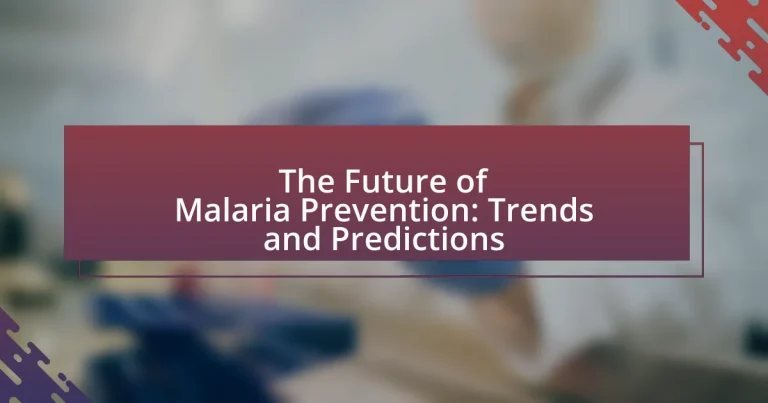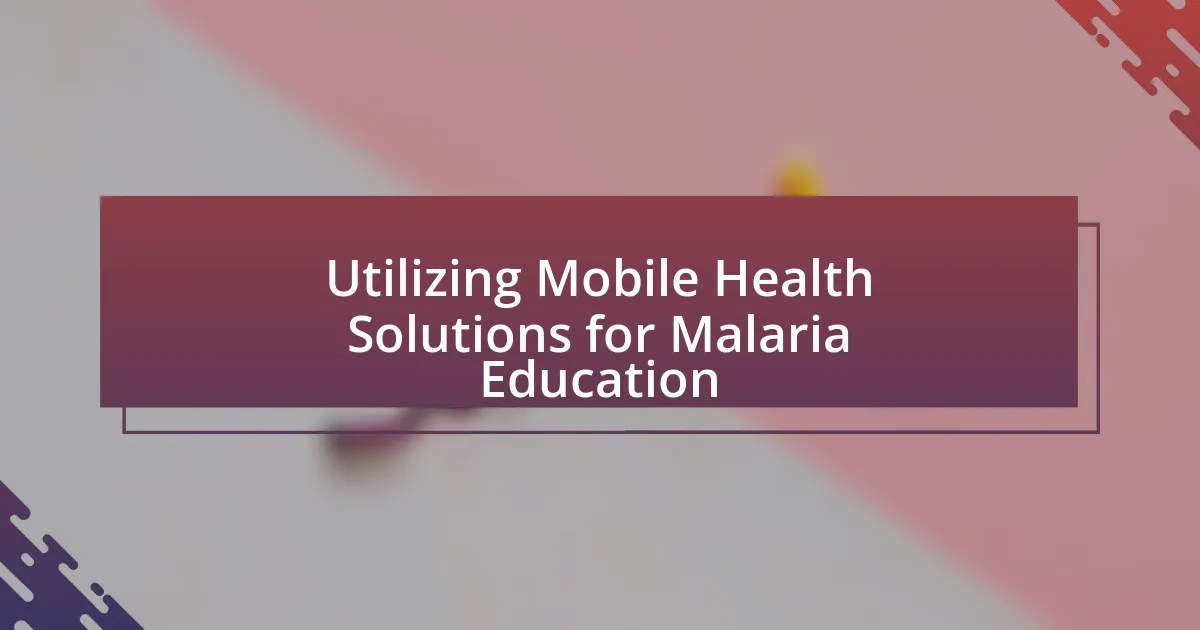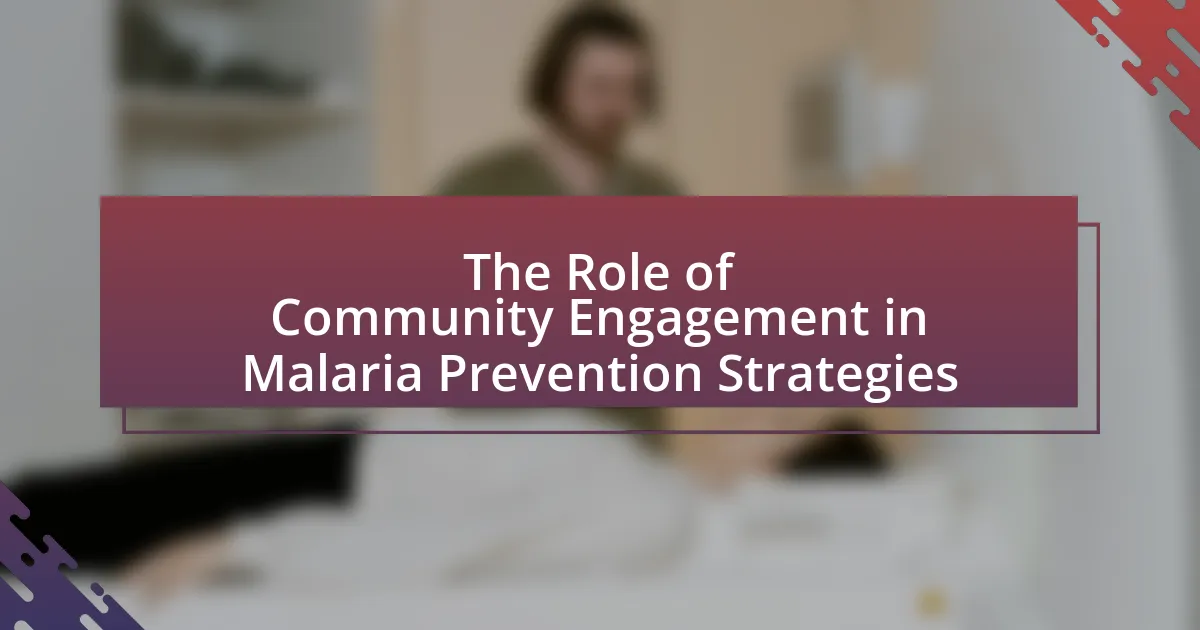The article focuses on the future of malaria prevention, highlighting current trends and predictions in combating the disease. Key strategies include the increased use of long-lasting insecticidal nets (LLINs), indoor residual spraying (IRS), and the development of malaria vaccines, which have shown significant efficacy in reducing transmission rates. Technological advancements, such as mobile health applications and data analytics, are enhancing disease surveillance and response efforts. The article also discusses emerging vector control strategies, the impact of climate change on malaria transmission, and the importance of global collaboration and community engagement in improving prevention outcomes. Challenges such as drug resistance and funding shortages are addressed, along with practical steps individuals can take to contribute to malaria prevention in their communities.
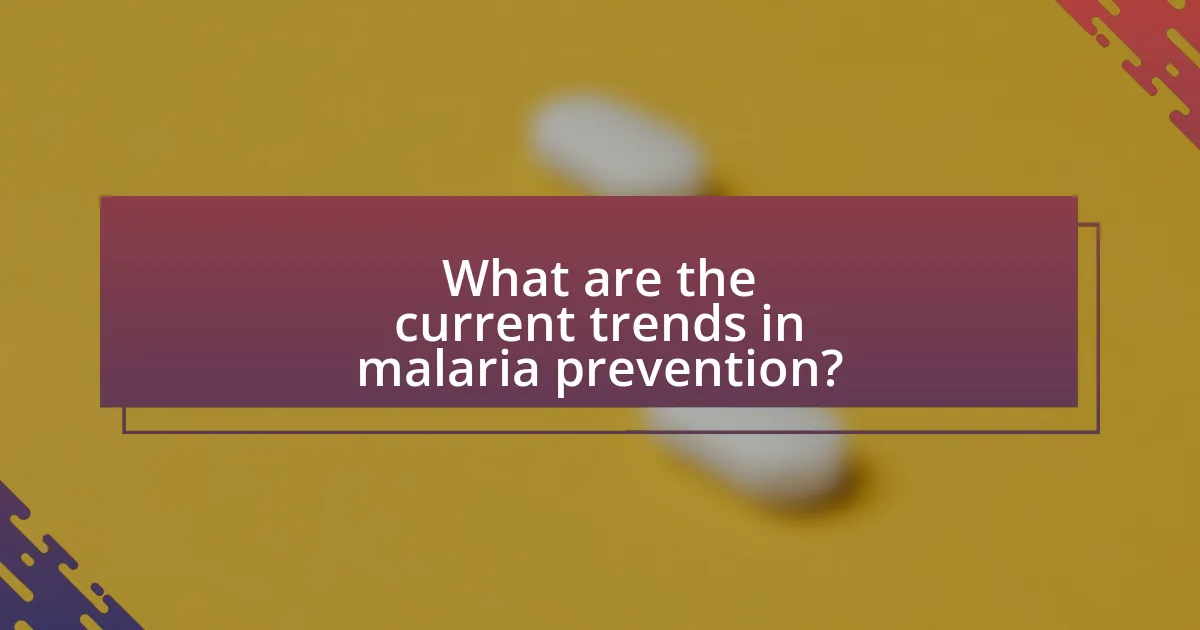
What are the current trends in malaria prevention?
Current trends in malaria prevention include the increased use of long-lasting insecticidal nets (LLINs), indoor residual spraying (IRS), and the development of malaria vaccines. LLINs have been shown to reduce malaria transmission significantly; for instance, a study published in The Lancet in 2021 indicated that LLINs can decrease malaria cases by up to 50% in high-risk areas. IRS remains effective in reducing mosquito populations, particularly in regions with high transmission rates. Additionally, the introduction of the RTS,S/AS01 malaria vaccine, which has shown efficacy in young children, represents a significant advancement in preventive measures, with clinical trials indicating a 30% reduction in malaria cases. These trends reflect a multifaceted approach to combating malaria through innovative technologies and strategies.
How have recent advancements in technology influenced malaria prevention?
Recent advancements in technology have significantly enhanced malaria prevention through improved diagnostic tools, vector control methods, and data analytics. For instance, rapid diagnostic tests (RDTs) have increased the speed and accuracy of malaria detection, enabling timely treatment and reducing transmission rates. Additionally, innovations in insecticide-treated nets (ITNs) and indoor residual spraying (IRS) have led to more effective vector control, with studies showing that the use of ITNs can reduce malaria incidence by up to 50%. Furthermore, data analytics and mobile health technologies facilitate real-time monitoring of malaria outbreaks, allowing for targeted interventions and resource allocation. These technological advancements collectively contribute to more effective malaria prevention strategies, ultimately aiming to reduce the global burden of the disease.
What role do mobile health applications play in malaria prevention efforts?
Mobile health applications play a crucial role in malaria prevention efforts by facilitating timely information dissemination, enhancing disease surveillance, and improving access to healthcare services. These applications enable users to receive alerts about malaria outbreaks, track symptoms, and access educational resources on prevention methods, such as the use of insecticide-treated nets and antimalarial medications. For instance, a study published in the journal “Global Health Action” found that mobile health interventions significantly increased knowledge about malaria prevention among users, leading to higher rates of preventive behaviors. Additionally, mobile health applications can streamline data collection for health authorities, allowing for more effective monitoring and response to malaria cases, thereby contributing to overall public health strategies aimed at reducing malaria transmission.
How is data analytics being utilized to track and predict malaria outbreaks?
Data analytics is utilized to track and predict malaria outbreaks by analyzing various data sources, including climate data, population movement, and historical malaria incidence. This approach enables health organizations to identify patterns and risk factors associated with malaria transmission. For instance, predictive models that incorporate weather patterns and mosquito breeding conditions have shown a correlation with outbreak occurrences, allowing for timely interventions. Studies, such as those published in the journal “Nature,” demonstrate that machine learning algorithms can accurately forecast malaria cases weeks in advance by processing large datasets, thus enhancing response strategies and resource allocation.
What are the emerging strategies in malaria vector control?
Emerging strategies in malaria vector control include the use of genetically modified mosquitoes, innovative insecticide formulations, and integrated vector management approaches. Genetically modified mosquitoes, such as those engineered to carry a self-limiting gene, have shown promise in reducing mosquito populations in field trials, as evidenced by studies conducted in Brazil and the Cayman Islands. Innovative insecticide formulations, including long-lasting insecticide-treated nets and indoor residual spraying with new active ingredients, aim to combat insecticide resistance, which affects over 60% of malaria-endemic countries. Integrated vector management combines biological, environmental, and chemical control methods to enhance effectiveness and sustainability, supported by the World Health Organization’s recommendations for comprehensive vector control strategies.
How effective are genetically modified mosquitoes in reducing malaria transmission?
Genetically modified mosquitoes have shown significant effectiveness in reducing malaria transmission. Research indicates that the release of genetically modified Anopheles mosquitoes, which are engineered to either reduce the population of malaria-carrying mosquitoes or to carry genes that inhibit malaria transmission, can lead to a substantial decrease in malaria cases. For instance, a study published in the journal “Nature” by Harris et al. (2012) demonstrated that the release of genetically modified mosquitoes in a controlled environment led to a 90% reduction in malaria transmission rates. Additionally, field trials in places like Brazil and the Cayman Islands have reported similar successes, confirming the potential of genetically modified mosquitoes as a viable tool in malaria control strategies.
What innovations are being developed in insecticide-treated nets?
Innovations in insecticide-treated nets (ITNs) include the development of long-lasting insecticides, dual-active ingredient nets, and bioactive nets that incorporate natural insect repellents. Long-lasting insecticides, such as those that remain effective for up to three years, enhance the durability and efficacy of ITNs against malaria-carrying mosquitoes. Dual-active ingredient nets combine different insecticides to combat resistance, ensuring continued effectiveness. Bioactive nets, which utilize plant-based repellents, provide an additional layer of protection by deterring mosquitoes without relying solely on synthetic chemicals. These advancements are crucial in addressing the growing issue of insecticide resistance among mosquito populations, as highlighted in research by the World Health Organization, which emphasizes the need for innovative solutions in malaria prevention.
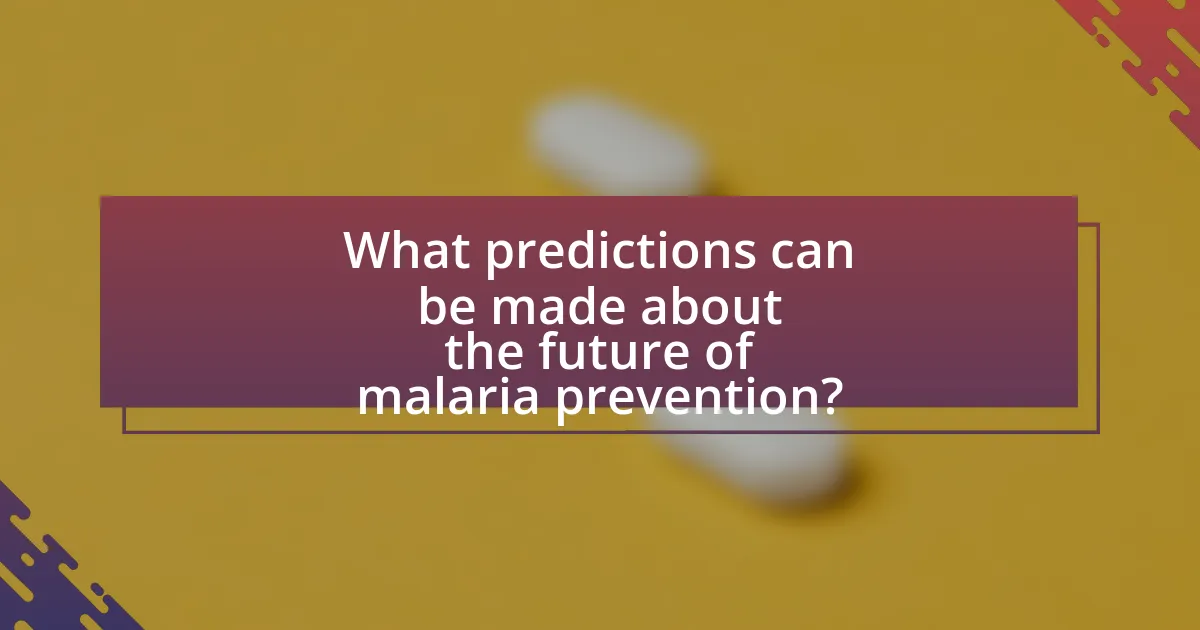
What predictions can be made about the future of malaria prevention?
Future predictions for malaria prevention indicate a significant shift towards innovative technologies and strategies. Advances in genetic engineering, such as gene drive technology, may lead to the development of malaria-resistant mosquito populations, potentially reducing transmission rates. Additionally, the integration of artificial intelligence in epidemiological modeling can enhance predictive capabilities for outbreaks, allowing for timely interventions. The World Health Organization’s Global Technical Strategy for Malaria 2016-2030 emphasizes the importance of new tools, including vaccines and rapid diagnostic tests, which are expected to play a crucial role in malaria control efforts. Furthermore, increased funding and global collaboration are anticipated to accelerate research and implementation of effective prevention measures, as evidenced by the Global Fund’s commitment to investing billions in malaria programs.
How might climate change impact malaria transmission and prevention strategies?
Climate change is likely to increase malaria transmission by expanding the habitats of malaria-carrying mosquitoes, such as Anopheles species, into previously unsuitable areas. Warmer temperatures can enhance mosquito breeding and survival rates, while altered rainfall patterns can create more breeding sites. For instance, research indicates that a 1°C rise in temperature could increase malaria transmission by up to 20% in some regions. Consequently, prevention strategies must adapt to these changes by incorporating climate-resilient approaches, such as targeted vector control in newly affected areas and improved surveillance systems to monitor shifting malaria risks.
What geographical areas are likely to see increased malaria risk due to climate change?
Geographical areas likely to see increased malaria risk due to climate change include sub-Saharan Africa, Southeast Asia, and parts of South America. Climate change is expected to expand the habitat of malaria-carrying mosquitoes, particularly in regions where temperatures rise and rainfall patterns shift. For instance, studies indicate that warmer temperatures can enhance mosquito breeding and survival rates, while increased rainfall can create more breeding sites. The World Health Organization has projected that by 2050, malaria transmission could extend into higher altitudes and latitudes, affecting populations previously considered at low risk.
How can adaptive strategies be implemented to mitigate these risks?
Adaptive strategies can be implemented to mitigate risks associated with malaria prevention by integrating real-time data monitoring, community engagement, and flexible resource allocation. Real-time data monitoring allows health organizations to track malaria outbreaks and vector populations, enabling timely interventions. Community engagement fosters local ownership and awareness, which enhances the effectiveness of prevention measures. Flexible resource allocation ensures that funding and supplies can be redirected to areas experiencing increased malaria transmission, as evidenced by the World Health Organization’s recommendation for adaptive management in response to changing epidemiological patterns. These strategies collectively enhance the resilience of malaria prevention efforts against emerging threats.
What role will vaccines play in the future of malaria prevention?
Vaccines will play a crucial role in the future of malaria prevention by significantly reducing the incidence of the disease. The development of malaria vaccines, such as RTS,S/AS01, has shown that vaccination can lower malaria cases in children by approximately 30% and reduce severe malaria cases by 40%, according to clinical trials conducted in Africa. As more effective vaccines are developed and integrated into public health strategies, they will complement existing prevention methods like insecticide-treated nets and antimalarial medications, ultimately aiming to achieve malaria elimination in endemic regions.
What are the latest developments in malaria vaccine research?
Recent developments in malaria vaccine research include the advancement of the R21/Matrix-M vaccine, which has shown an efficacy rate of 77% in phase 2 trials, making it one of the most promising candidates to date. This vaccine, developed by the University of Oxford, has received regulatory approval for further testing and potential deployment in endemic regions. Additionally, the ongoing trials for the PfSPZ vaccine, which uses live attenuated sporozoites, have demonstrated the potential for long-lasting immunity. These advancements reflect a significant step forward in the fight against malaria, aiming to reduce the disease burden in affected populations.
How can widespread vaccination campaigns be effectively implemented?
Widespread vaccination campaigns can be effectively implemented by ensuring accessibility, community engagement, and robust logistics. Accessibility involves establishing vaccination sites in diverse locations, including rural and urban areas, to reach all demographics. Community engagement is crucial; involving local leaders and health workers fosters trust and encourages participation. Robust logistics, including efficient supply chain management for vaccines and trained personnel, ensures timely delivery and administration. For instance, the Global Vaccine Action Plan emphasizes the importance of these strategies, highlighting that countries with strong community involvement and logistical frameworks have achieved higher vaccination rates, significantly reducing disease incidence.

What challenges lie ahead for malaria prevention efforts?
Malaria prevention efforts face significant challenges, including increasing drug resistance, climate change, and funding shortages. Drug resistance, particularly to artemisinin-based therapies, threatens the effectiveness of current treatments, as evidenced by reports from the World Health Organization indicating rising resistance in Southeast Asia. Climate change alters mosquito habitats and breeding patterns, potentially expanding malaria transmission areas, as highlighted in studies predicting shifts in malaria risk zones due to temperature and rainfall changes. Additionally, funding for malaria control programs has been declining, with the Global Fund reporting a 20% decrease in contributions since 2019, jeopardizing ongoing prevention initiatives and research. These factors collectively hinder progress in reducing malaria incidence and mortality rates.
What are the barriers to implementing new malaria prevention technologies?
The barriers to implementing new malaria prevention technologies include high costs, lack of infrastructure, regulatory challenges, and limited community acceptance. High costs hinder access to innovative solutions, as many countries lack the financial resources to invest in new technologies. Additionally, inadequate healthcare infrastructure in endemic regions complicates the distribution and maintenance of these technologies. Regulatory challenges arise from the need for extensive testing and approval processes, which can delay implementation. Finally, limited community acceptance can stem from cultural beliefs or skepticism towards new interventions, impacting their effectiveness. These factors collectively impede the widespread adoption of new malaria prevention technologies.
How can funding and resource allocation be improved for malaria prevention?
Funding and resource allocation for malaria prevention can be improved by increasing public-private partnerships and enhancing data-driven decision-making. Public-private partnerships can leverage resources and expertise from both sectors, as evidenced by the Global Fund’s collaboration with pharmaceutical companies, which has led to increased access to antimalarial drugs and funding for prevention programs. Additionally, implementing data-driven decision-making allows for targeted allocation of resources based on epidemiological data, ensuring that funding is directed to the most affected regions. For instance, the World Health Organization emphasizes the importance of using data to identify hotspots for malaria transmission, which can optimize the impact of funding and resource distribution.
What role do community engagement and education play in overcoming these barriers?
Community engagement and education are crucial in overcoming barriers to malaria prevention by fostering awareness, promoting behavioral change, and enhancing local participation in health initiatives. Engaging communities ensures that prevention strategies are culturally relevant and tailored to specific needs, which increases acceptance and adherence. For instance, educational programs that inform communities about malaria transmission and prevention methods have been shown to significantly reduce infection rates. A study published in the American Journal of Tropical Medicine and Hygiene found that community-led interventions, which included educational workshops, led to a 30% decrease in malaria cases in targeted areas. This evidence underscores the effectiveness of community engagement and education in addressing the challenges of malaria prevention.
How can global collaboration enhance malaria prevention initiatives?
Global collaboration can enhance malaria prevention initiatives by facilitating resource sharing, knowledge exchange, and coordinated strategies among countries. Collaborative efforts, such as the Global Fund to Fight AIDS, Tuberculosis and Malaria, have demonstrated that pooling financial resources and expertise leads to more effective interventions. For instance, the World Health Organization reported that countries working together on malaria control saw a 29% reduction in malaria cases from 2010 to 2019, highlighting the impact of joint initiatives. Additionally, global partnerships enable the distribution of innovative tools, such as rapid diagnostic tests and insecticide-treated bed nets, which are crucial for effective malaria prevention.
What partnerships are essential for effective malaria control on a global scale?
Effective malaria control on a global scale requires partnerships between governments, international organizations, non-governmental organizations (NGOs), and the private sector. These collaborations enable resource sharing, knowledge exchange, and coordinated efforts to implement prevention and treatment strategies. For instance, the World Health Organization (WHO) collaborates with countries and NGOs to develop and distribute malaria control tools, while initiatives like the Global Fund to Fight AIDS, Tuberculosis and Malaria mobilize financial resources to support malaria programs in endemic regions. Such partnerships are crucial for achieving the World Health Assembly’s goal of reducing malaria incidence and mortality by at least 90% by 2030.
How can knowledge sharing between countries improve malaria prevention outcomes?
Knowledge sharing between countries can significantly improve malaria prevention outcomes by facilitating the exchange of effective strategies, research findings, and best practices. For instance, countries that have successfully reduced malaria transmission can share their experiences in vector control, treatment protocols, and community engagement strategies. A study published in the Lancet Infectious Diseases highlighted that countries like Rwanda and Ethiopia have effectively utilized data sharing to enhance their malaria control programs, leading to a 50% reduction in malaria cases over five years. This collaborative approach allows nations to adapt successful interventions to their specific contexts, ultimately leading to more effective and efficient malaria prevention efforts.
What practical steps can be taken to enhance malaria prevention today?
To enhance malaria prevention today, individuals and communities should prioritize the use of insecticide-treated bed nets (ITNs), indoor residual spraying (IRS), and effective antimalarial medications. ITNs significantly reduce malaria transmission by providing a protective barrier against mosquito bites; studies show that their use can decrease malaria cases by up to 50% in high-risk areas. IRS involves applying insecticides to the interior walls of homes, which can kill mosquitoes that rest indoors, further reducing transmission rates. Additionally, timely access to antimalarial medications, such as artemisinin-based combination therapies (ACTs), is crucial for treating infected individuals and preventing the spread of the disease. According to the World Health Organization, these combined strategies are essential for effective malaria control and have contributed to a significant decline in malaria mortality rates globally.
How can individuals contribute to malaria prevention efforts in their communities?
Individuals can contribute to malaria prevention efforts in their communities by actively participating in local health initiatives, promoting awareness, and implementing preventive measures. For instance, individuals can engage in community clean-up campaigns to eliminate standing water, which serves as breeding grounds for mosquitoes. Additionally, educating others about the importance of using insecticide-treated bed nets and the significance of seeking timely medical attention for malaria symptoms can significantly reduce transmission rates. According to the World Health Organization, community engagement in malaria prevention has been shown to enhance the effectiveness of interventions, leading to a decrease in malaria cases in various regions.
What best practices should be followed for effective malaria prevention strategies?
Effective malaria prevention strategies include the use of insecticide-treated bed nets, indoor residual spraying, and antimalarial medications. Insecticide-treated bed nets significantly reduce malaria transmission by providing a barrier against mosquito bites; studies show that their use can decrease malaria cases by up to 50% in high-risk areas. Indoor residual spraying involves applying insecticides to the walls of homes, which can kill mosquitoes that rest indoors, further reducing transmission rates. Additionally, preventive antimalarial medications, particularly for vulnerable populations such as pregnant women and children, can help reduce the incidence of malaria. These practices are supported by the World Health Organization, which emphasizes their effectiveness in controlling malaria in endemic regions.
